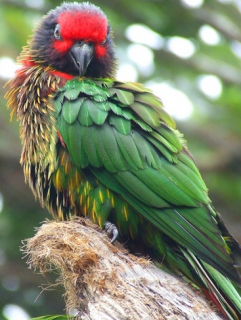Yellow-streaked Lory |
|
|
Also known as: Greater Streaked Lory, Cream-streaked Lory, Red-fronted Lory
Photos
View in GalleryDid You Know?
Yellow-streaked Lory pairs often engage in acrobatic flying with much calling to each other.Academic Research
Related publications: Chalcopsitta scintillataSpecies Profile
Genus: Chalcopsitta | Species: scintillata
Size:
31cm (12.1 in)
Weight:
180-245g (6.3-8.6 oz)
Subspecies including nominate:
three: C. s. scintillata, C. s. chloroptera, C. s. rubifrons
Colour Adult:
C.s. scintillata: Both adults mostly green, the feathers pale green on shaft on head to abdomen and bright yellow on breast and mantle; red forehead, lores, thighs and underwing coverts, in female less evident on forehead; red on sides of breast; underwing banded with yellow. Bill black. Eye ring bare and grey. Skin at base of bill grey/black. Eye orange/red.
C.s. chloroptera: As in scintillata, but narrower streaking in plumage; green underwing coverts with or without red markings.
C.s. rubrifrons: As in scintillata but broader, orange/yellow streaking in plumage.
Colour Juvenile:
C.s. scintillata: As in adults but with minimal amount of red on forehead; varying yellow marks at base of bill. Eye brown.
C.s. chloroptera: As in adults.
C.s. rubrifrons: As in adults.
Call:
Vocal while in flight and when perched. A electronic-sounding screech and many syllabled musical notes of varying tone and length.
Listen NowVideo Links:
Video 1 | Video 2More Information:
Content Sources:
CITES
BirdLife International
Cornell Lab of Ornithology/Birds of the World
Parrots: A Guide to Parrots of the World, Juniper and Parr, 1998
xeno-canto Yellow-streaked Lory, van Balen, Bas, XC121688
Parrots of the World, Forshaw and Cooper, 1989. 2010 edition
Parrots of the World, Forshaw, 2006.
Parrots in Aviculture, Low, 1992.
Parrots: Their Care and Breeding, Low, 1986.
Photos
View in GalleryDid You Know?
Yellow-streaked Lory pairs often engage in acrobatic flying with much calling to each other.Academic Research
Related publications: Chalcopsitta scintillataSpecies Care
Captive Status:
Fairly common
Longevity:
Not recorded.
Housing:
Aviary with well-drained floor (sloping concrete with drains) or suspended cage over concrete.
Diet:
Commercial type or a mixture of baby cereal (lactose-free), honey, and malt extract or molasses, mixed with bottle water, made fresh once or twice daily; also fresh fruit like apple, pear, orange, banana, cactus fruits and one or more of the following: carrot, corn on the cob, green leaves, rearing food made from hard boiled egg and wholegrain bread, ground to crumbly consistency.
Enrichment:
Hanging nectar bottles or cups around aviary, providing unsprayed browse with edible flowers, various chew (bird-safe woods) and plastic toys (non-toxic); provide bowls of water for bathing.
Nest Box Size:
10" x 10" x 20" (25.4cm x 25.4cm x 50.8cm) high.
Clutch Size:
2
Incubation Time:
24 days
Fledging Age:
11-13 weeks
Hatch Weight:
8g (0.3 oz)
Peak Weight:
198-227g (7-8 oz)
Weaning Weight:
198-213g (7-7.4 oz)
Specialist Club:
Photos
View in GalleryDid You Know?
Yellow-streaked Lory pairs often engage in acrobatic flying with much calling to each other.Academic Research
Related publications: Chalcopsitta scintillataSpecies Wild Status
World Population:
Unknown, stable.
IUCN Red List Status:
Least Concern
CITES Listing:
Appendix II
Threat Summary:
None at present. Common, with flocks of up to 30 birds seen.
Range:
C.s. scintillata: S New Guinea, east to Fly River, W Papua New Guinea.
C.s. chloroptera: SE and SC New Guinea, west to Fly and Noord Rivers, E Irian Jaya.
C.s. rubrifrons: Aru Islands, Indonesia.
Habitat:
Lowland savannahs and nearby forests, usually secondary growth. Also coconut plantations and mangroves. Up to 800m (2624 ft).
Wild Diet:
Forages for nectar or pollen of Syzygium, and nectar of Brassaia actinophylla, sago palms and Schefflera.
Ecology and Behaviour:
Gregarious, in pairs or groups of up to several dozen individuals; also spend time with Rainbow Lorikeets and Red-flanked Lorikeets in flowering trees. Aerial displaying frequent.
Clutch and Egg Size:
2 rounded eggs, about 30.0 x 25.0mm (1.2 x 1 in).
Breeding Season:
February and September. Nest is in tree cavity.
Photos
View in GalleryDid You Know?
Yellow-streaked Lory pairs often engage in acrobatic flying with much calling to each other.Academic Research
Related publications: Chalcopsitta scintillataMembers Only Resources
Please log-in now to find more research, resources and tools.
Not a Member?
Find more great information:
Gain exclusive access to 600+ pages of additional research, seminars and podcasts, specialists to ask your toughest questions, and dozens of other fun resources - when you become a WPT member.
Join Today >>

































